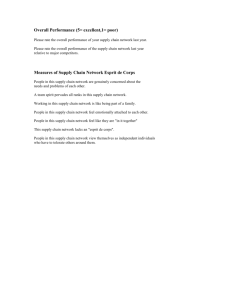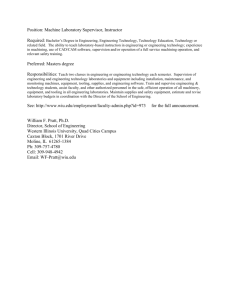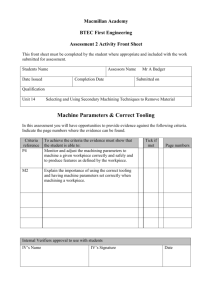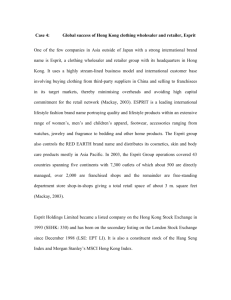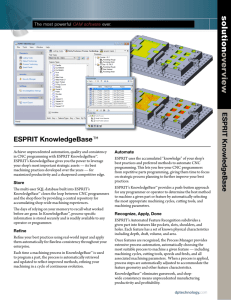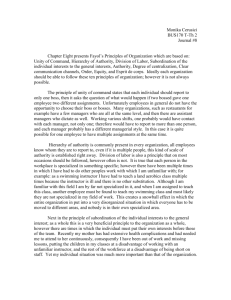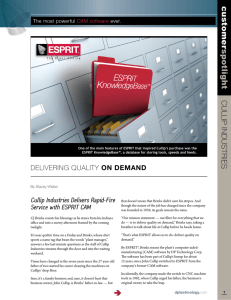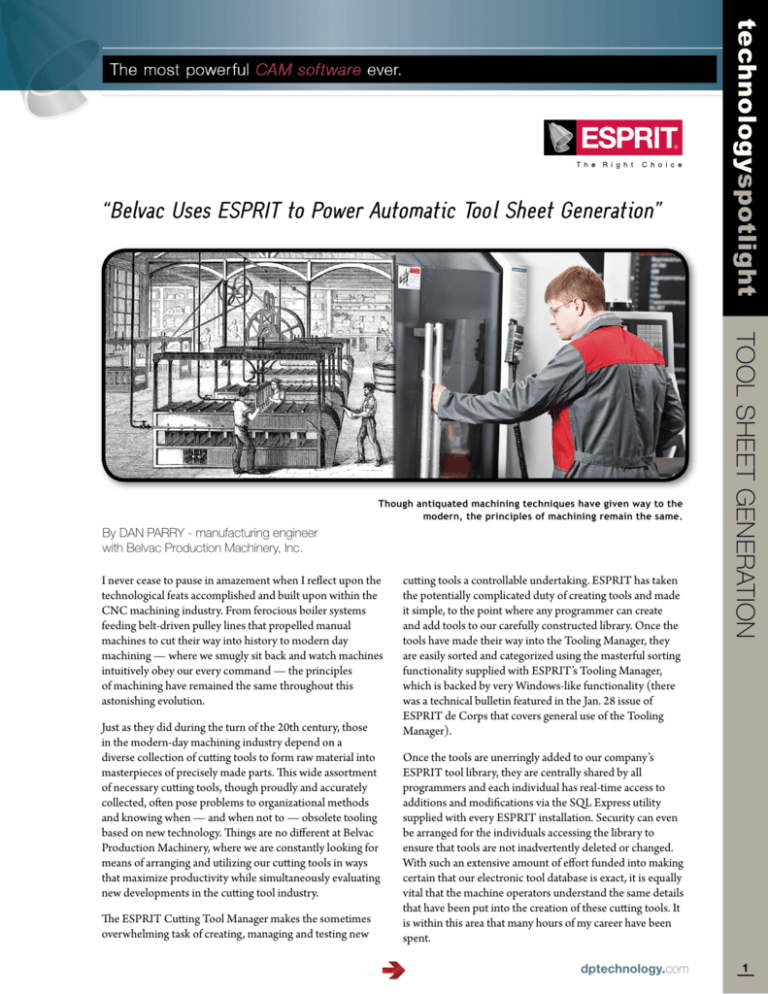
By DAN PARRY - manufacturing engineer
with Belvac Production Machinery, Inc.
I never cease to pause in amazement when I reflect upon the
technological feats accomplished and built upon within the
CNC machining industry. From ferocious boiler systems
feeding belt-driven pulley lines that propelled manual
machines to cut their way into history to modern day
machining — where we smugly sit back and watch machines
intuitively obey our every command — the principles
of machining have remained the same throughout this
astonishing evolution.
Just as they did during the turn of the 20th century, those
in the modern-day machining industry depend on a
diverse collection of cutting tools to form raw material into
masterpieces of precisely made parts. This wide assortment
of necessary cutting tools, though proudly and accurately
collected, often pose problems to organizational methods
and knowing when — and when not to — obsolete tooling
based on new technology. Things are no different at Belvac
Production Machinery, where we are constantly looking for
means of arranging and utilizing our cutting tools in ways
that maximize productivity while simultaneously evaluating
new developments in the cutting tool industry.
The ESPRIT Cutting Tool Manager makes the sometimes
overwhelming task of creating, managing and testing new
cutting tools a controllable undertaking. ESPRIT has taken
the potentially complicated duty of creating tools and made
it simple, to the point where any programmer can create
and add tools to our carefully constructed library. Once the
tools have made their way into the Tooling Manager, they
are easily sorted and categorized using the masterful sorting
functionality supplied with ESPRIT’s Tooling Manager,
which is backed by very Windows-like functionality (there
was a technical bulletin featured in the Jan. 28 issue of
ESPRIT de Corps that covers general use of the Tooling
Manager).
Tool Sheet Generation
Though antiquated machining techniques have given way to the
modern, the principles of machining remain the same.
technologyspotlight
“Belvac Uses ESPRIT to Power Automatic Tool Sheet Generation”
Once the tools are unerringly added to our company’s
ESPRIT tool library, they are centrally shared by all
programmers and each individual has real-time access to
additions and modifications via the SQL Express utility
supplied with every ESPRIT installation. Security can even
be arranged for the individuals accessing the library to
ensure that tools are not inadvertently deleted or changed.
With such an extensive amount of effort funded into making
certain that our electronic tool database is exact, it is equally
vital that the machine operators understand the same details
that have been put into the creation of these cutting tools. It
is within this area that many hours of my career have been
spent.
dptechnology.com
1
Without going into
too much detail
about why and how
the snapshot above
is created by the post
processor, we can take
a quick look to get a
general understanding
of what is happening
behind the scenes. This way someone can easily change the output to conform to their needs.
The first part of the code (i.e. program number, part number, set-up instructions, etc.) is controlled by the EX_STARTCODE
example in the post processor. A closer look proves to be somewhat self-explanatory when considering the terminology used
in EX_ STARTCODE.
Tool Sheet Generation
Being easy to use, centrally located and robust, the ESPRIT Tooling Manager became our primary and only electronic tool
library. We can now use the post processor to extract the parameters from within the ESPRIT tool and systematically arrange
it at the top of our NC code along with the rest of the standard information for a specific program that the machine operators
are accustomed to
seeing. Things like
Sample Tool Sheet
part number, program
number and set-up
instructions were
already located at
the top of each NC
code file, so it made
sense to put our
automatically-created
tool sheet here. The
red box encompasses
Belvac’s tool sheet.
technologyspotlight
I assumed there may be other ESPRIT users faced with this problem and therefore decided that I would use this article
to discuss the one method that I have found most useful. After trying and falling short with many different means of
communicating the details of a cutting tool library to the machine operators, I have finally found one that consolidates
multiple file types and eliminates the need for maintaining redundant information. Rather than maintaining multiple libraries
and/or databases of tooling information, we at Belvac decided to focus our attention where it had the biggest impact: the
ESPRIT Tooling Manager.
Next is a string of text representing column headings for the individual parameters that will be pulled from the ESPRIT tool
and placed in the corresponding columns.
Each column heading entails a two-letter acronym that corresponds to a field from within the ESPRIT tool page that it
symbolizes (e.g. TN is for Tool Number, TD is for Tool Diameter, etc.). Since there are quite a few acronyms, it may take a
dptechnology.com
2
technologyspotlight
Sample Generic tool setup
to sequentially pull the parameters from the ESPRIT tool
and populate the individual columns in the tool set-up sheet
using that data. The Tool Comment is then placed directly
underneath the parameters of the tool and can include any
additional specifics about the tool.
The next part of the post processor is where the real magic
happens. We use the EX_TOOLDEFINITION example
The CL File Number is used to call the value that is
associated with that particular field. To find out which CL
dptechnology.com
Tool Sheet Generation
while for the machine operators to remember what they
all stand for. To help with this scenario, we have provided
the machine operators with a picture of a generic tool that
depicts the dimensions on the tool that each column heading
signifies.
3
In conclusion, ESPRIT’s ability to automatically output a
tool sheet based on the tools used in a program provides
many benefits to our company. Potential errors are
eliminated by focusing solely on the tool information entered
within the CAM system rather than duplicating this data
inside of a tool management system or some other means of
storing electronic tools. We also estimate a conservative 3%
reduction in the time it takes to create a single program by
not having to create a separate tool sheet to deploy tool setup information to the machine operators. Not to mention the
time saved by not having to view, maintain and store multiple
file types since the tool sheet is directly within the NC code.
Tool Sheet Generation
In the seldom, but nevertheless preset, case where we need
to create a tool that uses a holder that cannot be defined
only by using the parameters supplied in a tool, we revert to
the custom shank functionality to properly define the tool.
The picture below shows an example of how it is possible to
use the custom shank option to define a tool holder that is
tapered.
While the ability to describe a custom tool holder using the
shank category is undoubtedly handy, it tends to throw a
wrench into allowing the post processor to handle tool-sheet
creation by extracting the parameters from the tools in the
program. To handle this situation, we have added an “if ”
statement within the EX_TOOLDEFINITION example to
allow the user to use Custom Settings to declare the values
that may not be output correctly if allowed to be driven by
the fields that would normally explain the dimensions for
certain factors of the tool. The “if ” statement, as explained
below, allows the user to set the Custom Setting 1 field to
a value of 1, then the Tool Length, Extension Diameter,
Bottom Length and Holder Diameter will all be defined
using Custom Setting fields.
technologyspotlight
File Number a particular field has, simply right click on a field
and select Edit Properties. For example, notice in the picture
below that the Tool Diameter field has CL File Number 103.
I suppose the marvelous capabilities and ever-changing
technology of cuttings tools is in some ways a double-edged
sword. It’s a constant chore to organize, store and utilize the
right cutting tool for the job, but nevertheless we wouldn’t
be able to accomplish the amazing achievements that take
place daily within the machining industry without them. “It’s
amazing what can be done with the right tools.” This was one
of my father’s favorite sayings when I was growing up. I’m
proudly passing the importance of that statement along to
my own son while trying to instill in him my appreciation for
the fantastic world of tools and manufacturing that surrounds
us.
Custom shank end mill holder
While it is usually a challenge to maintain our everexpanding tool libraries, DP Technology has ensured that
ESPRIT makes this duty one less thing to worry about. With
the undertaking of supplying our machine operators with a
detailed tool sheet out of the way, Belvac programmers have
dptechnology.com
4
Tool Sheet Generation
Parry’s son, Daniel, explores the fantastic
world of tools and manufacturing.
DP Technology Corp.
1150 Avenida Acaso
Camarillo, CA 93012 USA
technologyspotlight
that much more time to focus on automating other parts
of our processes. One win at a time, we will continue to
use ESPRIT, “The Most Powerful CAM Software Ever,”
to quickly and efficiently produce NC programs. g
Phone: 1 800 627-8479
Outside the US: + 1 805 388-6000
Email: esprit@dptechnology.com
ESPRIT is a registered trademark of DP Technology Corp.
©2011 DP Technology Corp. All rights reserved.
dptechnology.com
5


